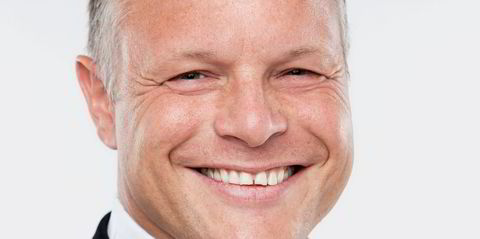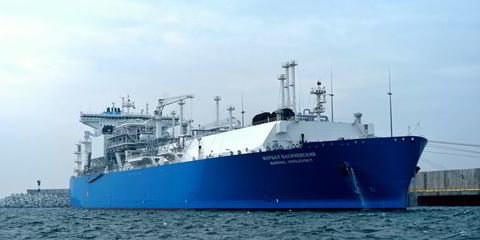A few days before deck officer Danielle Randolph sailed on a TOTE Maritime ship on what she did not know would be its final journey, she shot off a text message to a close friend.
The message had a photo she took of graffito written somewhere on the 5,330-lane-metre El Faro (built 1975), where the 24-year-old Maine native was second mate. It read: “God be with us all,” the friend recalled in an interview with National Transportation Safety Board (NTSB) investigators.
“Apparently, I’m not the only one that’s having a hard time up here,” wrote Randolph, who had been complaining that the 40-year-old combination containership ro-ro (conro) was a “rust bucket”, according to the friend.
This exchange is part of a chilling and dramatic timeline that has emerged from documents and testimony in a comprehensive investigation into the final journey of the US-flag El Faro, which sank on 1 October 2015 after suffering a series of problems while it was pummelled by Hurricane Joaquin. All 28 Americans and five Poles onboard died.
Another crew member, first assistant engineer Keith Griffin, was tired in the run-up to the vessel’s departure on 29 September.
The 33-year-old Floridian told his wife, Katie, who was pregnant, that he was working long hours to fix problems on the ship, making his time on El Faro the “worst tour” he had ever been on.
“Everything is breaking on here and I’m just working my ass off,” he said, as Katie recalled in an interview with investigators seeking the cause of the sinking.
The storm that would become Joaquin turned into a tropical depression on the evening of 27 September while it was 360 miles (580km) northeast of the Bahamas’ San Salvador Island. By 20:00 the next day, it had become a tropical storm.
At nearly 17:00 on 29 September the National Hurricane Center (NHC) warned that the storm could become a hurricane the next day. Six hours later, the agency said it could become a hurricane later that night.

Fully loaded with containers and vehicles, El Faro departed Jacksonville, Florida, at 20:10 Eastern Standard Time with 27 officers and crew, a riding gang of five Polish workers carrying out preparations for the ship’s redeployment to the Alaska trade and an extra chief engineer to oversee their work.
Jack Jackson, a 60-year-old able-bodied seaman (AB) from Jacksonville, never grew tired of this part of the job. The allure of a career at sea may have been fading after four decades, but his brother Glenn says he always said there was nothing like casting off at the beginning of a journey. “Even until his last voyage, I don’t think that ever diminished,” Glenn said.
But out in the Atlantic, Joaquin proved an unpredictable storm, with prediction errors well above the NHC’s average. That’s because on the night of the 28th it took a path that weather forecasters describe as atypical.
US models indicated that Joaquin would churn northwest or westward. Instead, it began marching southward, and official forecasts were late in showing this motion in their projected tracks, according to an NTSB meteorology report.
Forecasts would also underestimate its intensity. Overnight on 29 September, Joaquin picked up muscle quickly, strengthening to a hurricane by two o’clock the next morning — although that would not be announced for some hours.
Early on the morning of 30 September, Captain Michael Davidson and chief mate Steven Shultz discussed the storm ahead while looking over weather data. According to a transcript of bridge conversations on the ship’s voyage data recorder (VDR), which was recovered more than 10 months after the sinking, they talked over what action to take as the storm churned to the northeast of El Faro.
The two men agreed to alter course slightly to head south of Joaquin’s projected track line, but left open the option of taking an alternative route through Old Bahama Channel to get into more sheltered waters further from the storm.
This was a decision that took place on the ship with no input from the owner, TOTE Maritime, whose officials testified that they gave broad permission to the master to determine such decisions.
“I think that’s a good little plan, chief mate,” Davidson told Shultz. “At least I think we got a little distance from the centre.”

Back on shore, at 7.39am, the NHC announced that Joaquin had become a hurricane.
“We’ll be about 60 miles south of the eye. It should be fine,” Davidson later told AB Jackson. “We are gonna be fine — not should be — we are gonna be fine.”
During the afternoon, a US Coast Guard (USCG) aircraft flew over the Bahamas, warning vessels of the coming storm. Lieutenant Lance Lynch, the pilot, told investigators that the message urged all underway vessels to seek shelter.
On the bridge of El Faro, the VDR transcript at 14:14 shows the text of messages with the Coast Guard urging mariners to take extreme caution after hurricane warnings were issued for several islands, including Rum Cay, not far from the path El Faro would be taking, although a call for ships to take shelter was not on the transcript.
About an hour later, El Faro’s sistership El Yunque passed several miles off, headed in the opposite direction.
“They’re tryin’ to get away from the storm too,” Randolph, the second mate, said on the bridge.
“Nobody in their right mind would be drivin’ into it,” said a crewman identified only as AB-2.
“We are,” Randolph responded.
After new weather reports came in, Davidson and the chief mate returned to set a new course that was still further south of the storm’s projected track. But they still did not choose to seek the shelter of Old Bahama Channel.
Davidson told the third mate, Jeremie Riehm, a 46-year-old from Delaware who was taking over the watch at that time, to pick up as much speed as possible with a push from the winds.
After departing the bridge at about 20:00, the master did not return for more than six hours. However, he said Riehm could contact him if he did not like what he saw in the weather ahead.
Riehm didn’t like what he saw. Reports on the Weather Channel suggested that Joaquin was more powerful than indicated by the ship’s weather data. Minutes after Davidson had left the bridge, the third mate worried, presciently, that the storm might not make the northward turn in the forecasts.
“Maybe I’m just being a chicken little. I don’t know,” Riehm told helmsman Jack Jackson.
“Some captains would have taken one look at that and went, ‘We’re gonna go the Old Bahama Channel. We’re not takin’ any chances’,” Riehm said as the evening went on.
After El Faro’s printer had spat out more weather data, Riehm called the master, apologising for waking him. Winds were forecast at 100mph (160km/h). And at 04:00 the next morning, he told the master, the ship’s course would bring it within 22 miles of the storm’s centre.
But Davidson, whose office was equipped with more sophisticated weather data delivered in packages that were somewhat behind those on the bridge, ordered Riehm to stay the course, a transcript shows.
“He seems to think that we’ll be south of it by then, so the winds won’t be an issue,” Riehm told Jackson, explaining that the ship would be in the weaker southwest quadrant of the storm at its closest point.
To Jackson, known for his sense of humour, that sounded like a “Nantucket sleigh ride”, a term for the wild ride immediately after harpooning a powerful whale.
At that point, Jackson confided that he had already laid out his life jacket and survival suit, referring to it with another colourful sailor’s term, a poopy suit.
“He had a complete understanding of the crisis situation they were rapidly approaching,” his brother Glenn said in an interview after reading the transcript.
At 22:49, the NHC announced that Joaquin had strengthened to a Category 3 hurricane. That means winds of “devastating” power at 96-112 knots (178-207km/h).

As the cyclone roared in the shrinking distance, Griffin, the first assistant engineer, sent his pregnant wife an email.
“It’ll be a stormy night so I probably won’t get much sleep,” he wrote, before concluding: “I love you.”
As midnight approached, Randolph entered the bridge to take over the watch and began to discuss the situation with Riehm. Concerned over the proximity to the storm and the dire forecasts in media reports, the pair pored over charts to find a path to the shelter of the Bahamian archipelago.
Randolph, who was responsible for navigation on the ship, spotted a solution. At 01:20 on 1 October, she called Davidson and told him the storm had strengthened, and apparently asked him about the potential for veering south to avoid Joaquin.
Again, the captain said he wanted to continue the course.
“Captain was sound asleep,” Randolph said.
The conversation between them had gone just as the second mate’s mother, Laurie Bobillot, predicted it would months before the transcript was released.
“I think, because she did the charting and all that, that she probably brought it to his attention,” Bobillot told investigators in an interview a month after the sinking. Her daughter would have plotted another route, she said, but would have followed the captain’s order.
Around 02:45, waves were slamming El Faro, hitting so hard that they were jostling the ship off course and activating its steering alarm. Randolph was surprised the captain had not yet made it to the bridge.
Davidson returned at a little after 4am and seemed to say he had been sleeping like a baby. He seemed unworried at first, saying the weather was what crew could expect every day after the ship’s planned redeployment to Alaska. But within about 30 minutes, El Faro’s troubles began to emerge.
The ship was starting to list, and chief engineer Richard Pusatere complained that this could affect its lube oil pressure. Keeping the lubes flowing was no small matter. Without lube oil, the steam propulsion engines would shut down, leaving the ship powerless to manoeuvre in the towering waves that were pummelling it.
Amid zero visibility, Davidson began guiding an AB at the helm through steering measures to try to take off some of the tilt.
Shultz, the chief mate, then informed the captain that a trailer on the ship’s second deck had tipped over. Experts have told investigators with the NTSB and USCG that a cargo shift is likely to have occurred on the vessel, although when it happened in the chain of events is unclear. Rolling cargo is of particular concern, because even a single vehicle could cause a domino effect.
“I’ve never seen it list like this,” said Jeffrey Mathias, a TOTE chief engineer who was on El Faro to supervise the Polish riding crew. He speculated that there must be a problem with more than one container stack.
As the drama unfolded that morning, Bobillot received an email from her daughter. “Not sure if you’ve been following the weather at all,” Randolph wrote. “But there is a hurricane out here and we are heading straight into it. Give my love to everyone.”
Bobillot told investigators that she knew the email meant something was wrong. She sent an email in response: “Please be careful, love you, Mom.” But error messages told her it could not be delivered.
At 05:45, another problem emerged. Davidson sent the chief mate to investigate flooding in the starboard side of the number three hold. A scuttle, or hatch, had blown open and water was rising in the hold where vehicles were stowed. The crew tried to pump the water out with a bilge pump and to move ballast from the starboard ramp tanks to the port tanks.

The master also directed the helmsman to manoeuvre so that El Faro’s list shifted from starboard to port.
Coast Guard investigators have found that El Faro was vulnerable to flooding through its cargo hold ventilation, if listing at a sharp enough angle. And a USCG report has found that it could take flooding of just one compartment in hold three to doom the vessel in harsh weather conditions.
By 06:00, the scuttle was shut, but 12 minutes later, Davidson said: “I think we just lost the plant.” El Faro’s propulsion had failed, its lube pressure apparently too low. Davidson ordered the crew to begin pumping ballast back to starboard to relieve the list and allow the lubes to flow.
Within a few minutes, it seemed as though the efforts were working to get the power plant back online, but at 06:48 Davidson said there was still no propulsion.
With engines offline and significant flooding in hold three, Davidson still wasn’t yet planning to abandon ship. But admitting the ship was in dire straits, he decided to call TOTE. After leaving a voicemail on the direct line for John Lawrence, TOTE’s director of fleet safety, he called the company’s emergency call centre at 07:05.
“Oh man, the clock is ticking,” he said, before asking for a qualified individual to report the situation.
Finally reaching Lawrence, he explained that the source of water was secured but there was a “very healthy port list” and the engineers could not get the lube oil pressure back up.
“The crew is safe. Right now, we’re tryin’ to save the ship,” he said, noting that the crew’s safest bet was to stay with the vessel.
The call served as a warning to TOTE that the ship was about to send a message to the Coast Guard that it was suffering an emergency. Randolph activated the alert at 07:13.
“Wake everybody up! Wake ’em up!” the captain said in what investigators described as an urgent, angry tone.
Waters were rising, with cars floating in the holds. The engineers could do nothing to start the engines with the heavy list.
Davidson rang the general alarm at 07:26 but was still telling crew that they would stay with the ship. Minutes later, that changed, and he ordered the “abandon ship” alarm at 07:29.
“Tell ’em we’re going in,” he said. “Bow is down. Bow is down.”
He yelled for crew to throw rafts in the water.
In the final seconds of recorded audio, Davidson and a panicked helmsman, AB Frank Hamm, were alone on the bridge, as the captain urged the crewman to follow him to safety.
“I’m a goner,” yelled Hamm, a father of five children and a grandfather.
“No you’re not,” said Davidson, before a low-frequency rumble began to build. “It’s time to come this way.” They were the last words known to have been spoken on El Faro.
'Never again': El Faro families say crew died unnecessarily
Terry Davis, the widow of able-bodied seaman (AB) Brookie Davis, took time off work to listen to every arduous hour of the Coast Guard’s three rounds of investigative hearings into El Faro's sinking.
“We, the people left behind, can’t do a thing to change what’s already happened,” she said outside the Jacksonville convention centre where the hearings were held. “What we do have to do is keep it in the front of the public eye so something like this never happens again.”
Mrs Davis and other family members of those lost were a regular presence at the investigations into the sinking where the loss of their loved ones was discussed in such unprecedented detail.
Each person who has spoken to TW+ says the main goal is to ensure that what happened to the 33 men and women on El Faro never happens again.
Pastor Robert Green, whose son LaShawn Rivera was the cook on El Faro, says it is clear from the information that has emerged from the investigations that key “decision points” — moments when a different choice could have taken the ship away from disaster — were missed.
“There were opportunities to make decisions multiple times to turn around and go in a different direction,” Green said. “Certainly, the safest thing to do would be to just avoid the storm and not to be in any proximity of the storm. And I think that’s probably where the sinking has got to change.”
Glenn Jackson, the brother of AB Jack Jackson, says he did not miss a single minute of the hearings. “My brother died unnecessarily, just like the other 32 crew members,” he said.
PLUS POINT: REVIEWING THE EVIDENCE
The sinking of El Faro has led to three rounds of public hearings, interviews and three expeditions to find the wreck and recover its voyage data recorder.
The US Coast Guard has convened a Marine Board of Investigation in Jacksonville, headed by Captain Jason Neubauer, while the National Transportation Safety Board is carrying out a separate but parallel probe led by Brian Young. Neither agency has set a date for the release of their final reports.
It took three expeditions over 10 months before the US authorities recovered the voyage data recorder (VDR) that has shed so much light on El Faro’s final voyage. Search crews on the US Military Sealift Command’s oceangoing tug USNS Apache found the hull, 41 miles (66km) northeast of Crooked Island in the Bahamas, in a sonar image a month after El Faro went down. The bridge deck had been severed from the vessel and took several more days to find, but the Apache had to return to port before it could find the VDR.
Five months later, the hydrographic vessel Atlantis made a second effort that located the device but could not retrieve it. A remotely operated submersible lowered from the Apache finally lifted the device from 15,000 feet below the ocean’s surface in August 2016. Only after that could investigators start to pore over 26 hours of audio and other data.




